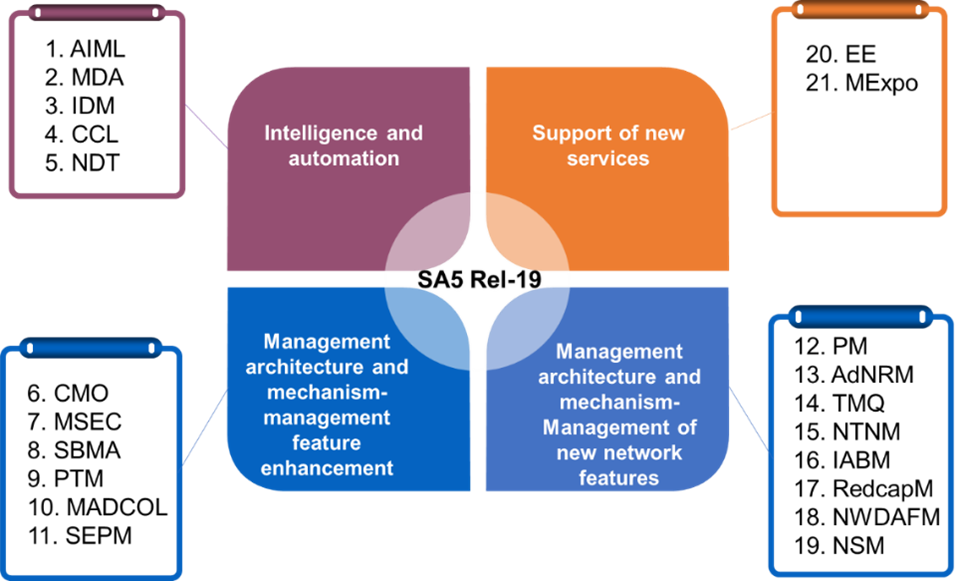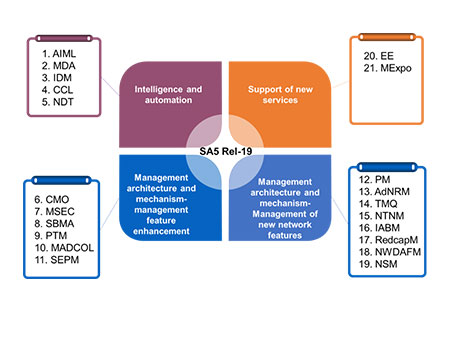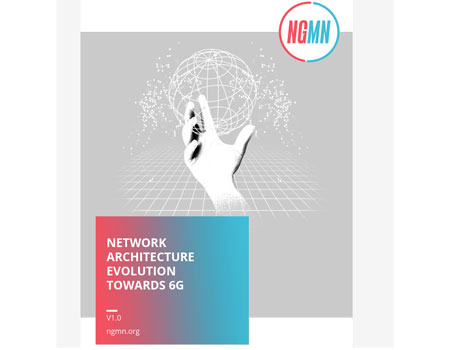by Zou Lan, 3GPP SA5 Chair
First published June 2024, in Highlights Issue 08
3GPP WG SA5 Rel-19 standardization work includes management and orchestration requirements, management stage 2 and management procedures, and stage 3 OpenAPI and YANG solution sets to provide complete management interoperability capabilities for the 5G network in a multi-vendor environment.
SA5 takes the WG SA1 defined service requirements as input and focuses on the details of management requirements. By closely following the progress of other 3GPP WGs which produce new network features, SA5 also provides timely stage 2 and stage 3 management capabilities to allow operators to be able to manage the new network functions via standardized management solutions.
SA5 Rel-19 Management and Orchestration topics
There are twenty-one Rel-19 management and orchestration topics currently, categorized by the following four technical areas; Intelligence & automation, Support of new services, Management architecture & mechanism-management feature enhancement and for new networks features.
Intelligence and automation
AI/ML management, management data analytics, enhancement of intent driven management, closed control loop management and network digital twin:
- AI/ML management (AIML) studies the mechanisms of how to enable and facilitate the efficient deployment, operation of the relevant AI/ML features located in 5GC, RAN or management functions. It is targeted to provide manageable capability to perceive how AIML model works with lifecycle management, giving the operator the confidence of taking advantage of AIML technology under their own supervision.
- Management data analytics (MDA) investigates the potential management analytics solutions for Energy efficiency analytics, End-to-End performance analytics including Edge computing domain, Data correlation analytics, ATSSS performance analytics, Non-3GPP access performance analytics, UE throughput analytics, Fault management related analytics and alarm prediction, Software Upgrade Validation.
- Intent driven management (IDM) SA5 specified basic intent management features in Rel-18 to enable operators to express standardized intent expectation and targets to the intent handler, so that the intent handler can continuously use intelligence and automation mechanisms to seek optimal solutions for the requested intents. In Rel-19, more enhanced management functionalities like Intent negotiation mechanisms, network intent to support new business opportunities, adopting natural language to express intent will be discussed. With the new enhancement features, operators could interact with the intent handler more efficiently and extend the intent capability to support new services.
- Closed control loop (CCL) investigates the dynamic closed control loop creation for communication service assurance, Conflict Detection and Resolution across multiple CCLs. Considering the CCL could be disintegrated into multiple parts each coming from different vendors, a study on whether there would be any advantages or constraints for the use of multi-vendor CCL could provide evaluation insights to the industry.
- Network Digital Twin (NDT) is a new concept recently introduced in the telecommunication area. It could help operators to efficiently verify changes in network operation’s potential impact on the real network before it takes effect. The network behavior with the new configuration and policy can be emulated in the digital twin environment, operators could adjust the decision based on the emulation result. Network digital twin could also construct a full view of network topology and traffic, which can help the operator with efficient end-to-end or single-domain fault localization, traffic path optimization, prediction and avoidance of signaling storms. In Rel-19 study, the investigation on how RAN optimization and service assurance could potentially benefit from network digital twin technology will also be taken into account.
Support of new services
Management capability exposure and energy efficiency management:
- Management capability exposure (MExpo) focuses on defining a generic approach for discovery and exposure of SA5 management service capabilities to external consumers including verticals. The study will also investigate exposing network slice capability in network sharing scenarios for communicating with external consumers.
- Energy efficiency management (EE) aims to study new or enhanced Energy Consumption (EC) and Energy Efficiency (EE) KPIs and measurements while considering various granularities, and also provide the estimation of Carbon emissions efficiency and information on renewable energy consumption to operators. This study also addresses how to measure or estimate the energy consumption of containerized network functions.
Management architecture and mechanism-management feature enhancement
Management and orchestration of cloud, Service based management architecture enhancement, Plan management, Data Management, Data subscriptions and reporting, Enablers for Security Monitoring:
- Management and orchestration of cloud (CMO) plans to analyze the use cases which utilize the VNF generic OAM functions, study the use cases that utilize the newly developed industry solutions for management of cloud native network functions which leverage industry standards not limited to ETSI NFV MANO, and solutions for 3GPP management system to support different cloud deployment scenarios.
- Service based management architecture (SBMA) focuses on elaboration on usage guidance of model driven service, and also target to provide collection of the management capabilities and advertise management capability mechanisms.
- Plan Management (PlanM) studies the possibility for the operator to build the complete future configuration in a step-by-step approach. An operator could create and update a planned configuration that may be activated in the future. By validating the planned configuration in advance, it’s possible to increase the likelihood of success when activating it in the real network.
- Data Management (MADCOL) specifies methods to discover and collect historical management data and standardized mechanism to manage external management data.
- Data subscriptions and reporting (SREP) studies the potential solutions to avoid redundant subscriptions for the same data in the NFs and 3GPP management system. It will help to improve operational efficiency when the data collection is requested by an increasing number of automation functions in the 3GPP system.
- Enablers for Security Monitoring (MSEC) studies the collection, management and correlation of security alarms collected from 5GC, RAN, MnFs and UEs.
Management architecture and mechanism-management of new network features
Performance measurements and KPIs, the network resource modeling to manage the new network features of the 5G core and RAN, Subscriber and Equipment Trace and QoE collection management, Management of NTN, IAB node, Redcap, NWDAF and network sharing:
- Performance measurements and KPIs (PMKPI) specifies new 5G performance measurements and KPIs for Mobility Enhancements, XR (Extended Reality) and media service, Mobile Terminated-Small Data Transmission, NR Multicast and Broadcast Services, Access Traffic Steering, Switch and Splitting (ATSSS) and UE level measurements.
- Network resource modeling (adNRM) specifies 5GC and NR network resource models to allow operators to manage new network features, also provide 3GPP defined slicing solution to satisfy GSMA developed network slice service requirements in NG.116.
- Subscriber and Equipment Trace and QoE collection management (TMQ) continues the enhancement of the trace collection measurements and QoE data collection information as the RAN and 5GC progress.
- Management of NTN (NTNM) studies the management requirement and potential solution to manage regenerative satellite, Store and Forward (S&F) satellite, and end to end network (including RAN domain and CN domain) in NTN scenarios.
- Management of IAB node (IABM) studies mechanism on how IAB node connects to OAM system, enhancement to Plug and Connect NE to OAM system, continuity of OAM connectivity during IAB node mobility and MBSR roaming over PLMNs, IAB FCAP management.
- Management of Redcap (RedcapM) studies configuration to support RedCap related initial BWP and eDRX, new performance measurements and KPI to measure resource load of RedCap network and Inactive UEs.
- Management of NWDAF (NWDAFM) studies configuration to support NWDAF accuracy checking capability, Analytics Exposure in Roaming Case and Federated Learning, and evaluates the the network data collection efficiency of NWDAF.
- Management of network sharing (NSM) studies trace job and collection requirements for participating operators, scenarios related to access rights of MOCN management data, and support of Indirect Network Sharing scenarios.
SA5 Rel-19 Management and Orchestration Cooperation
WG SA5 works in close cooperation within 3GPP and also with external non-3GPP working groups (e.g. ETSI, GSMA, ITU-T etc.), which are related to management technology. The following diagram shows the potential cooperation in Rel-19.
Examples include; the management exposure topic, cooperation with GSMA OPG, CAMARA, TM Forum and WG SA6 to construct end to end management exposure solution by integrating the vertical customers’ requests with the network solutions. For the Energy efficiency topic, cooperation with WG SA2, WG RAN3, ETSI EE, ITU-T, ETSI NFV could give us a broader overview of network energy consumption and efficiency.
Summary
WG SA5 management and orchestration takes an important role in the network and service ecosystem. Inside 3GPP, SA5 closely maintains the network and service management of the 3GPP network. Outside 3GPP, SA5 shares its work and actively contributes to end-to-end management solutions.
In Rel-19, in addition to the management of new network features, operators may also get more management features to improve operational efficiency and achieve performance assurance by using intelligence, and build good basis for operators to provide new agile services to their customers.
Useful links for SA5 Rel-19 topics
- SA5 Rel-19 approved WIDs/SIDs: https://forge.3gpp.org/rep/sa5/MnS/-/wikis/SA5/Rel-19-Moderated-Topics
- Management and Orchestration APIs: https://forge.3gpp.org/rep/sa5/MnS




 Technology
Technology




